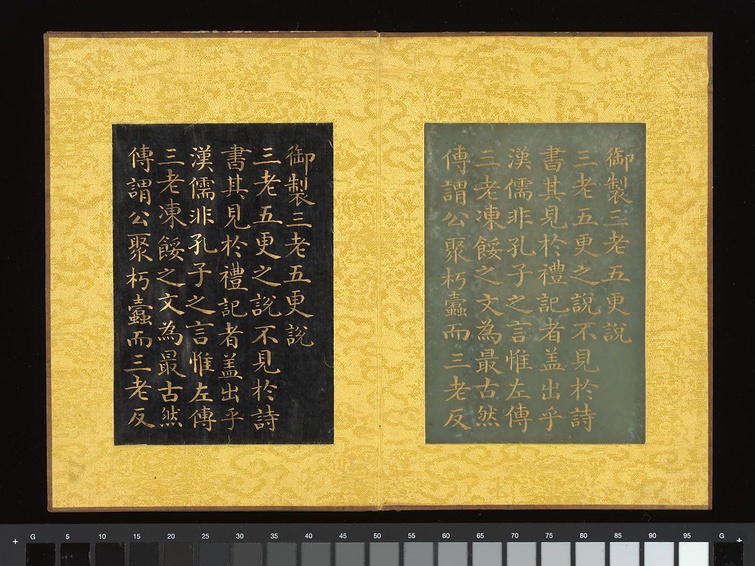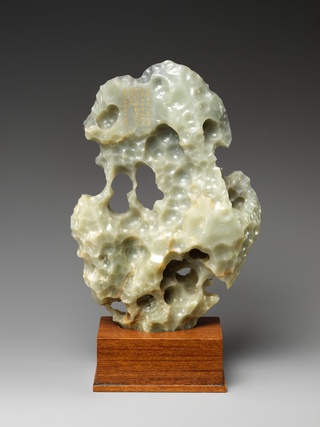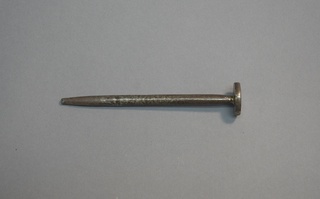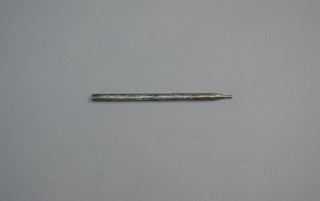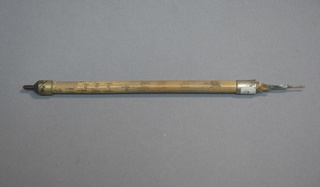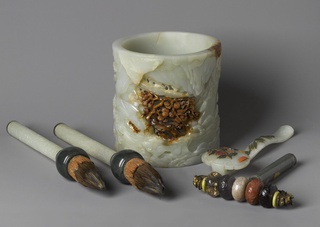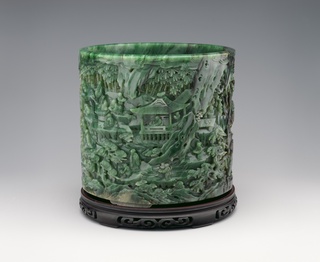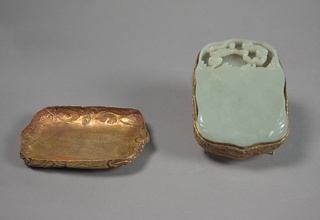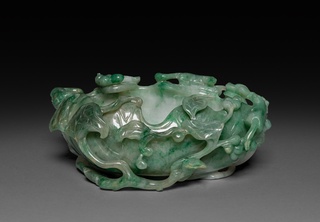Painting with Jade in Qing-Dynasty China
By Reina Gattuso•June 2022•12 Minute Read
The imperial Chinese literati valued calligraphy and painting as two of the most sophisticated arts. They saw jade as the most precious of materials. Therefore, they prized jade brushes and other tools for both painting and calligraphy. These tools represent the moral values of scholarly culture. They also can help us understand histories of labor, craftsmanship, and social hierarchy in the Qing Dynasty.
Introduction
Imagine you are holding this album from late 18th-century China. It’s a treatise on respecting one’s elders, composed by the Qianlong Emperor and created by the finest court jade workers and calligraphers.
Unknown, Album of the Note on Respect of Elders composed by the Qianlong Emperor, 1736–95. Metropolitan Museum of Art. Born as Hongli, the fourth emperor of the Qing dynasty contributed to the growth and preservation of the arts, literature, and cultural heritage during his reign.
Unknown, Album of the Note on Respect of Elders composed by the Qianlong Emperor, 1736–95. Metropolitan Museum of Art. Born as Hongli, the fourth emperor of the Qing dynasty contributed to the growth and preservation of the arts, literature, and cultural heritage during his reign.
You open the elaborately carved cover. On the left of each spread, calligraphers have carefully painted gold characters on the dark paper. On the right page, carvers have incised the same text into thin sheets of jade.
Scholars in Qing Dynasty China considered calligraphy and brush painting the most elevated artforms. They viewed jade as the purest of stones. The combination of calligraphy and jade, therefore, marks this album as a precious embodiment of imperial virtue.
Painting and calligraphy are two of the four traditional arts of the elite Chinese scholar class, whom English-speaking academics also call literati. Scholars used silk and paper for both forms. They used the same ink and brushes for both painting and calligraphy. The literati valued the two arts as representations of the artist’s interiority.1 2 Qing scholars often used calligraphic tools made of jade.
Artisans shaped jade into painting tools, themselves pieces of functional art. Scholars handled the resulting brushes, brushpots, and inkstones in the delicate choreography of calligraphy. We can study the way human beings interacted with this precious stone to better understand the meaning of jade for Qing-era people, and the social hierarchies within the artistic production of the era.
Jade, Gentlemen, and Laborers
Commercial painters worked in Qing Dynasty China; so did painters in the imperial workshop.3 Yet the artists who typically enjoyed the most cultural prestige were elite scholar-officials. In theory, any unenslaved man in Qing society could become a scholar by preparing for and passing the civil service exams. In practice, hereditary elites had the most resources to educate their sons. Women were not permitted to take the civil service exams.4
The scholar-official class consisted of bureaucrats, court officers, magistrates, educators, and lawyers. They considered themselves the pinnacle of virtue and refinement.5 Scholar-artists made works that combined the “four perfections” of poetry, calligraphy, painting, and the carving of the artist’s seal.6 7
Literati and Craftsmen
The Qing dynasty witnessed an outpouring of jade work.8 The imperial court employed its own workshop of expert jade carvers.9
The literati used jade calligraphic tools, but they didn’t make them. Indeed, literati typically believed in a hierarchy of the arts. Poetry, painting, and calligraphy were more refined pursuits than making brushes or inkstones.10 This is a distinction rooted in what scholar Dorothy Ko calls a “hierarchy of head over hands” that characterized Chinese imperial culture, including in the Qing era.11 These values were so ingrained that scholar-artists sometimes celebrated paintings that appeared to lack technical skill, claiming they symbolized the scholar’s transcendence of commercialism and “mere craftsmanship.”12
In contrast to this supposed hierarchy between head and hands, writing and toolmaking equally require intellectual and physical labor.13
Virtuous Jade
One way the literati expressed their status and refinement was through collecting and admiring jade objects.
Archaeologists have evidence that ancient Chinese people used jade for rituals as early as the third millennium BCE. Ancient Chinese people frequently included jade ritual objects in elite burials.14 Taoist writers claimed that jade conferred immortality.15 In the Shuowenjiezi, a second-century CE Chinese dictionary, scholar Xu Shen wrote that jade embodied the virtues of kindness, moral rectitude, bravery, and purity.16
When ethnically Manchu rulers formed the Qing dynasty in the 17th century, elites still considered an appreciation for jade a marker of the scholar-gentleman.17 Members of this class made a habit of collecting uniquely shaped, naturally occurring stones, usually limestone, called scholar’s rocks. The ornament below is an imitation scholar’s rock. An artist carved it out of jade.
The artist also inscribed this scholar’s rock with a poem written by the Quianlong Emperor in 1757.18 The ornament thus unites precious jade with the esteemed arts of poetry and calligraphy, making it quite the status symbol.
Shaping Jade
While imbued with lofty values, jade objects are the work of human hands. This includes the workers who mined jade, the merchants who traded it, and the craftspeople who shaped it. Sculptors painstakingly transformed the unyielding stone into forms so elegant, it can be hard to believe they are the work of human hands.
As much as elites tried to police class lines, the boundaries between scholar and artisan blurred in the Qing era. Trained scholars who could not pass the civil service examinations might become inkstone makers or calligraphy brush dealers, while high-ranking artisans might take up poetry.19
Materials and Process
We actually use the word “jade” to refer to two different kinds of green stone, jadeite and nephrite. Both are harder than steel and range in color from pure white to brilliant green.20 Chinese artists highly prize white nephrite, called mutton fat jade. Ancient Chinese people sourced nephrite from what is now Siberia and Turkestan. They began using jadeite in the 17th century and imported it from what is now called Myanmar.21
Artists could labor over a single intricate jade piece for months or even years.22 Chinese jade workers used iron rotary machines from the 500s until around 1960.23 Workers powered the wheel with a pedal. They fixed drills, diamond points, and leather wheels to a spinning shaft, holding the jade against the attachment to abrade it.
The artist could hold the jade in one hand while continuously dousing the jade with a mixture of sand and water. The sand helped the rotating tool abrade the jade. Drills gave the work a basic shape.
Jade workers used tools like this diamond point implement to carve the jade. Diamond is one of the only minerals hard enough to cut jade. Artists attached polishing wheels made of soft leather to the spinning shaft for final buffing.
Using Jade to Shape Words and Paintings
Scholars used the “four treasures of study” — brush, ink, inkstone, and paper—to paint and write.24 They often owned ornate jade brush sets which they used for both painting and calligraphy. Scholars may have hoped that jade’s association with moral purity imbued their work.
Brushes and Holders
Jade brush sets were status symbols that often sported carved literary references, signifying the owner was a learned individual. This set consists of a brush jar, two brushes, a ceremonial ruyi scepter, and a roller for blotting ink.25
For the brush jar in this set, the carver took advantage of natural brown coloring in the otherwise white jade to craft intricate detailing of lingzhi fungus and a pine tree. Ancient Taoists believed that eating lingzhi could confer immortal life, while pine trees represented the gentlemanly virtue of steadfastness.26 27 Brush jars often included designs with symbols of immortality, as well as inscribed poems.
Artisans made brush handles of anything from bamboo to jade, with bristles of wolf, goat, rat, or rabbit hair.28 In this set, the jade handles have worn, a mark of the writers’ touch over time.29
Jade is cool to the touch, but quickly warms to the heat of a human hand.30 As a brush’s owner gripped its handle to write, they must have felt the warming presence of the buttery stone.
Brush holders frequently featured designs with literary allusions. This carving shows a famous outdoor poetry competition from ancient Chinese history.31 32 The artist used the natural emerald green and white variegation on the jade to depict vibrant leaves and striated mountains.
Gardens were common motifs, since they were often sites of literary gatherings. The literati associated them with the values of naturalness and rectitude.33
The Act of Writing
Before computers or modern pencils and pens, writing was a mix of choreography and alchemy. Writers, usually elites, had to follow certain steps to make ink and prepare their writing implements.
Scholars rubbed a moist stick of ink-cake, a mixture of soot and glue, onto their inkstone. They could control the tone of the ink, from faint gray to deep black, by varying the amount of water they added.34 Inkstones could be made of any hard material. Some of the most precious were jade.
Scholars rested their wrists on the handrests to prevent themselves from smudging the fresh ink as they wrote. The literati associated jade hand rests with the virtues of modesty and restraint.37
Brushwashers served the practical purpose of removing excess ink from brushes and cleaning them after use. But they were also symbolic. The artisan carved this jade example, below, in the form of a lotus leaf, a common shape for scholarly implements.38 The gleaming, green and white jade has the juicy luster of fresh leaves.
The lotus is an important Buddhist symbol. It is rooted in the mud at the bottom of a pond, yet emerges as a pure, fragrant blossom.39 Lotuses float on top of the mire of earthly desire. Jade also embodied this nobility of character. Every time a scholar dipped their brush into the inky water of a lotus-shaped bowl and it emerged clean, they enacted this symbolic purity.40
Labor and Jade
Scholarly culture was an elite, patriarchal one. We can see jade calligraphic implements as holding the values of purity, rectitude, and moral virtue that the literati ascribed to them. Or we can take a step back and, alongside Dorothy Ko, see calligraphic implements as denoting “elite male subjectivity”—self-conception and worldview—“in its tangible material form.”41
We can also refocus on the labor that went into producing these implements. Artisans left their mark on their creations, both through their skill and with literal signatures. This assertion of artistic originality could be fraught. According to one legend, a Ming Dynasty emperor forbade any courtly jade carver from signing their name to their works. A famously skilled carver, Lu Zigang, defied the order by signing his name in fine letters in a dragon’s mouth. The emperor challenged him to a display of skill. The carver produced work so fine, the emperor reluctantly forgave him rather than executing him.42
During the Qing dynasty, inkstone makers working in different materials often signed their work, communicating a sense of ownership and pride. This era also saw a few skilled women carvers achieve success.43 While the literati ascribed elevated virtues to jade calligraphic tools, they are the work of human hands. By centering the labor of workers and artisans, we can bring this precious stone back to earth.
Reina Gattuso is a content writer on the Curationist team, and an independent journalist covering gender and sexuality, arts and culture, and food. Her journalism connects analysis of structural inequality to everyday stories of community, creativity, and care. Her work has appeared at Atlas Obscura, The Washington Post, Teen Vogue, The Lily, POPSUGAR, and more. Reina has an MA in Arts and Aesthetics (cinema, performance, and visual studies) from Jawaharlal Nehru University in New Delhi, India, where her research focused on sexuality in Hindi film. She writes and teaches writing to high school students in New York City.
Citations
“Four Arts.” Wikipedia, https://en.wikipedia.org/wiki/Four_arts. Accessed 3 May 2022.
Hearn, Maxwell K. “The Grandeur of Art During the Qing.” Asia for Educators, Columbia University, http://afe.easia.columbia.edu/qing/art.html. Accessed 3 May 2022.
Hearn.
“Imperial Examination.” Wikipedia, https://en.wikipedia.org/wiki/Imperial_examination. Accessed 3 May 2022.
“Scholar-Official.” Wikipedia, https://en.wikipedia.org/wiki/Scholar-official. Accessed 3 May 2022.
Yu, Shuishan. “Writing an Image: Chinese Literati Art.” Oakland University, https://our.oakland.edu/bitstream/handle/10323/3876/Chinesecatalog.pdf?sequence=1. Accessed 3 May 2022.
Hearn.
Fuxiang, Guo. “Emperor Qianlong’s Imperial Jade Archers’ Rings.” Arts of Asia, 2021, https://artsofasia.com/2021/10/01/emperor-qianlongs-imperial-jade-archers-rings/. Accessed 16 April 2022.
Ko, Dorothy. "The Social Life of Inkstones: Artisans and Scholars in Early Qing China." University of Washington Press, 2017, https://www.google.com/books/edition/The_Social_Life_of_Inkstones/. Accessed 3 May 2022.
“Chinese Gardens: Pavilions, Studios, Retreats.” The Metropolitan Museum of Art, https://www.metmuseum.org/exhibitions/listings/2012/chinese-gardens. Accessed 3 May 2022.
Moll-Murata, Christine. State and Crafts in the Qing Dynasty (1644-1911). Amsterdam University Press, 2018, https://library.oapen.org/bitstream/id/2997ac0b-c776-4c81-9cf2-42f23e7eafaa/1001705.pdf. Accessed 3 May 2022.
Ko.
“Chinese Gardens: Pavilions, Studios, Retreats.”
Ko.
Lyons, Elizabeth. “Chinese Jades.” Expedition, vol 20 issue 3, 1978, Penn Museum, https://www.penn.museum/sites/expedition/chinese-jades/. Accessed 16 April 2022.
Lyons.
Silbergeld, Jerome and Michael Sullivan. ”Chinese jade.“ Britannica, https://www.britannica.com/art/Chinese-jade. Accessed 3 May 2022.
Fuxiang, Guo. “Emperor Qianlong’s Imperial Jade Archers’ Rings.” Arts of Asia, 2021, https://artsofasia.com/2021/10/01/emperor-qianlongs-imperial-jade-archers-rings/. Accessed 16 April 2022.
“Rock-form ornament with poem composed by the Qianlong Emperor.” The Metropolitan Museum of Art, https://www.metmuseum.org/art/collection/search/748363. Accessed 3 May 2022.
Ko.
“Mohs scale of mineral hardness.” Wikipedia, https://en.wikipedia.org/wiki/Mohs_scale_of_mineral_hardness. Accessed 3 May 2022.
“A Concise Guide to Antique White Jade.” Marchant, https://www.marchantasianart.com/guide/a-concise-guide-to-antique-white-jade/. Accessed 3 May 2022.
Wang, Mingying and Guanghai Shi. “The Evolution of Chinese Jade Carving Craftsmanship.” Gems and Gemology, Spring 2020, pp. 31–53, Gemological Institute of America, https://www.gia.edu/doc/SP20-chinese-jade-carving-evolution.pdf. Accessed 3 May 2022.
Wang and Shi.
“Writing Brush.” China Culture, http://en.chinaculture.org/library/2008-01/24/content_44518.htm. Accessed 3 May 2022.
“Brush Jar with an Imperial Inscription.” Brooklyn Museum, https://www.brooklynmuseum.org/opencollection/objects/3106. Accessed 3 May 2022.
Heng, Cheryl. Shine, 26 July 2019, https://www.shine.cn/feature/art-culture/1907269088/. Accessed 3 May 2022.
Song Art Museum. “Pine Trees in Ancient Chinese Paintings.” Google Arts and Culture, https://artsandculture.google.com/story/pine-trees-in-ancient-chinese-paintings-song-art-museum/LAXBpplj6OFSLQ?hl=en. Accessed 3 May 2022.
“Writing Brush.”
“Brush Jar with an Imperial Inscription.”
“Earflare Set.” The Metropolitan Museum of Art, https://www.metmuseum.org/art/collection/search/317430. Accessed 3 May 2022.
“Brush holder with Gathering at the Orchid Pavilion.” The Metropolitan Museum of Art, https://www.metmuseum.org/art/collection/search/42058. Accessed 3 May 2022.
“Gathering at the Orchid Pavilion,” The Metropolitan Museum of Art, https://www.metmuseum.org/art/collection/search/48901. Accessed 3 May 2022.
“Chinese Gardens: Pavilions, Studios, Retreats”
Ko.
Ko.
Ko.
“Wrist Rest.” The Metropolitan Museum of Art, https://www.metmuseum.org/art/collection/search/39869. Accessed 3 May 2022.
“Brush Washer in the Shape of Lotus Flowers, Seedpod and Leaves.” Worcester Museum, https://worcester.emuseum.com/objects/39055/brush-washer-in-the-shape-of-lotus-flowers-seedpod-and-leav;. Accessed 3 May 2022.
“Lotus.” Philadelphia Museum of Art, https://www.philamuseum.org/collection/object/318939. Accessed 26 April 2022.
“Scholar’s Objects – Brush Pots and Washers.” Chinese Antiques U.K., https://www.chineseantiques.co.uk/scholars-objects-brush-pots-and-washers/. Accessed 3 May 2022.
Ko.
“Chinese Jade (Part 2) : Material and Technique.” Yun Boutique, 22 March 2016, https://www.yunboutique.com/blogs/divine-land-gemstone-compendium/113338885-chinese-jade-part-2-material-and-technique. Accessed 3 May 2022.
Ko.
Reina Gattuso is a content writer on the Curationist team, and an independent journalist covering gender and sexuality, arts and culture, and food. Her journalism connects analysis of structural inequality to everyday stories of community, creativity, and care. Her work has appeared at Atlas Obscura, The Washington Post, Teen Vogue, The Lily, POPSUGAR, and more. Reina has an MA in Arts and Aesthetics (cinema, performance, and visual studies) from Jawaharlal Nehru University in New Delhi, India, where her research focused on sexuality in Hindi film. She writes and teaches writing to high school students in New York City.
